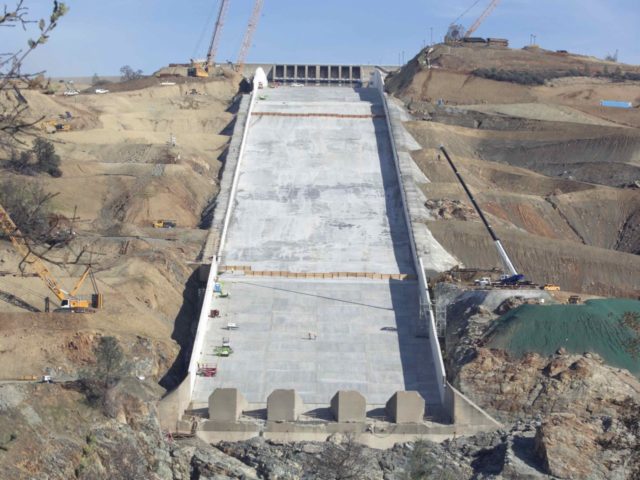Dam safety experts are warning that a three-day storm set to hit Northern California beginning on Thursday could risk an overflow event at the partially rebuilt Oroville Dam spillway.
Northern California’s second-largest March precipitation in 20 years, and warm temperatures kicking off an early snow melt in the Sierra Nevada mountains, have raised the water level at the 700-foot-deep Lake Oroville to just 36 feet below the point where dam safety operators must open the partially repaired Oroville Dam main spillway.
The Federal Energy Regulatory Commission (FERC) and the California Department of Water Resources (DWR), which owns the state’s second-largest reservoir, had intended to keep the water storage in Lake Oroville at or below 40 percent, about 1.4 million cubic feet of the lake’s 3.5 million cubic foot capacity. But last month’s storms increased storage to 2.2 million cubic feet.
After last year’s Oroville Dam spillway failure, the DWR created the 2017-18 Lake Oroville Winter Operations Plan to ensure public safety in the event of major storm events. The plan triggers more aggressive outflow at the Hyatt Powerplant, and potential main spillway use in case the water level reaches 830 feet by April.
The current forecasts show the potential for inflows to raise the reservoir from the current 794 feet to near the 830-foot trigger level by the middle of next week.
At the same time, the Kiewit Construction Corporation is still supervising a two-year, $710 million repair of the dam and spillway infrastructure following last year’s near collapse of the dam and the emergency forced evacuation of 188,000 residents downstream. The first phase of construction shut down last autumn for the rainy season, and was expected to finish this summer.
California Division of Dams officials claim the spillway chute is in working order after first phase repairs, and inspectors will be onsite around the clock to monitor the performance of the spillway and correct any problems if the spillway floodgates are opened.
DWR spokesman Erin Mellon told SFGate.com, “Hopefully we don’t need to use the spillway,” but if it is needed, “we’ve done a lot of hydraulic monitoring. We’re confident in the construction.”
Division of Dam engineers are not concerned about the structural integrity of the dam, but rather the sustainability of the main spillway, which only has a temporary roller-compacted concrete surface (versus the extremely smooth permanent concrete surface to be completed later). High-speed water flow for a prolonged period over a rough temporary surface could cause the same cavitation friction that chewed up and destroyed the main spillway last year.
Kiewit built a series of temporary cutoff walls along the half-finished main spillway as a precautionary measure in the event of an emergency overflow event. But last year’s 100,000-cubic-feet-per-second (cfs) overflow could take out the cutoff walls.
In anticipation of the coming rainstorm, DWR increased outflows at the Hyatt Powerplant to 10,000 cfs. Maximum outflow capacity at the plant is 12,500 cfs, and DWR can also open the River Valve Outlet to release another 4,000 cfs before opening the spillway. At the height of last year’s crisis, the spillway was releasing 230,000 cfs.
DWR has officially notified state and federal regulatory agencies; public safety organizations; the Butte County Sheriff’s office; and all local, state and federal elected officials about the potential increase in outflows and use of the spillway.

COMMENTS
Please let us know if you're having issues with commenting.